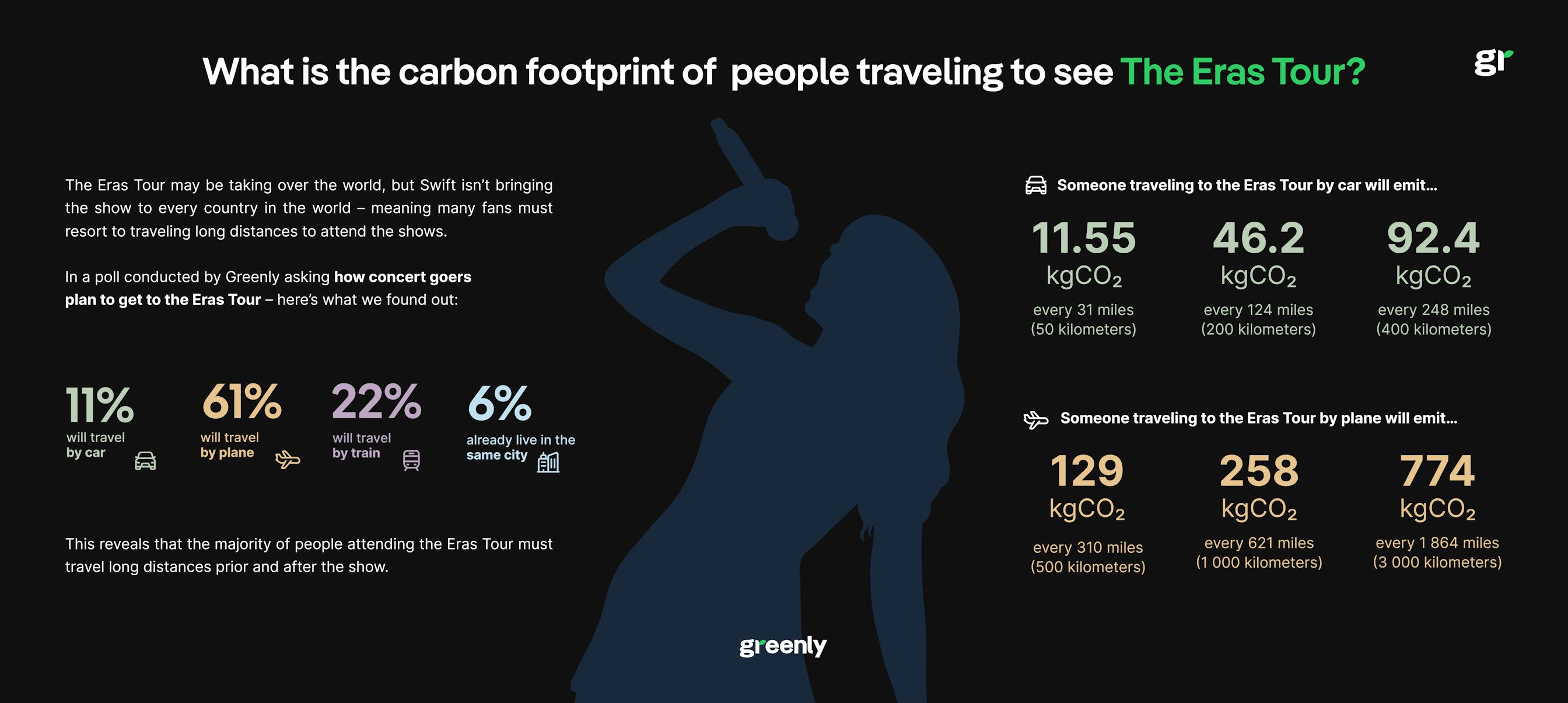ESG / CSR
Industries
The Environmental Impact of the Eras Tour & Ways We Can Move Forward



Important: The recommendations presented in this data story are merely suggestions. They are not ready-to-use solutions that can be applied without a thorough evaluation of their advantages and disadvantages. Every organization or individual aiming to reduce their carbon footprint must take into account various criteria and variables unique to their situation. This is why Greenly emphasizes the need for expert guidance in the development of any environmental or low-carbon transition strategy.
Unless you’ve been living under a rock, you’ve probably heard of the Eras Tour – otherwise known as “The Music Industry” powerhouse Taylor Swift’s ongoing concert tour: which spans over 3 hours, 10 albums, and the successful 18-year-and-counting career Swift has had.
Swift has been gaining massive media attention since the start of her Eras Tour, such as by her ability to boost the local economy of cities and states across the US and Australia – with similar projections being expected when she brings the Eras tour to Europe this summer.
Critics have cited the Eras Tour as a successful career victory lap – as the tour plans to span five continents over the course of 152 shows.
The undeniable economic and cultural impact of Taylor Swift has suffused all areas of life – from politics to travel. Swift’s fans have made an effort to travel to new and far places just to see the Eras tour with their own eyes, which has in turn inspired even more Taylor-themed travel: such as a Taylor Swift themed cruise from the Bahamas – which is planned to set sail in 2024.
Swift not only influences travel plans – but politics, too. Amidst the upcoming 2024 presidential election, many project that Swift may have an influence over Joe Biden’s re-election.
In this data story, we will break down the environmental impact of the Era’s Tour, Swift’s overall power, and ways we can make these monumental tours more sustainable moving forward.
Taylor Swift and Climate Change
With so much global influence at her fingertips, many have continued to wonder why Swift hasn’t brought attention to another global catastrophe – climate change.
In fact, Olivia Wilde made a controversial tweet in late 2023 saying, “I wish Taylor Swift was in love with a climate scientist” – possibly referring to the new relationship between Swift and NFL star Traivs Kelce, where Swift has already produced 138 tonnes of carbon dioxide emissions flying back and forth to Kansas City.
All eyes are on Swift, especially as the Eras Tour is set to restart with shows in Japan, Singapore, and Australia.
In this data story, we’ll examine some of the major environmental impacts Swift’s Eras tour, such as:
- Swift’s carbon footprint during the first two legs (U.S. & South America) of the Eras Tour from the use of her private jet;
- Travel emissions created by concert goers via plane, car, and train – presuming 50,000 are in attendance;
- The impact of concert goers purchasing merchandise, such as the impact of t-shirts and assuming 50% of concert goers (assume 50% of people will buy a t-shirt);
- The emissions created from concert attendees obliged to purchase water bottles at the concert (using a baseline of 40,000 people per stadium and 1 bottle per person);
- A summary of risks related to carbon credits of the Eras Tour.

Taylor Swift’s Private Jet & Emissions From Her Travel For her Eras Tour
In late 2023, Swift became a billionaire – and her intense fame coupled with her new financial status has meant that for the Eras Tour, hotels are out of the picture and travel is via her private jets.
Business Insider revealed this year that Swift’s private jet had spent around 166 hours in the air during the U.S. leg of the Eras Tour, and since then – her private jet usage has garnered immense media attention.
Swift has two different private jets: the N621MM and the N898TS, which are Dassault’s Falcon 7X and 900LX models respectively – one of which she uses to go to and from her concerts herself, and the other being used as a base in Nashville where her business is registered.
Her private jets can both travel at faster speeds than commercial jets:
| Private jet | Speed (mph) |
|---|---|
| N621MM | 700 mph |
| N898TS | 590 mph |
In addition to the faster speeds associated with private jets, aircrafts owned by celebrities such as Swift often have approval to fly at 50,000 feet – which helps to pass commercial air travel and shorten flight time.
Much of the controversy of Swift’s private jet usage is due to her unnecessary travel. For instance, Swift was spotted traveling from Buenos Aires back to NYC from November 12th, 2023 and November 17th, 2023 before the Rio Shows began during the South American leg of the Eras Tour.
Throughout the U.S. leg of the tour in Spring 2023, Swift often traveled back and forth between the city she held her Eras tour concert and her residence in NYC – one of the reasons presumably to return to Electric Lady Music studio to record her upcoming album, The Tortured Poets Department.
It is important to note that these calculations were made prior to Swift selling her Falcon 900LX private jet in February 2024 – the jet she was using for the majority of her long-haul travel throughout the U.S. and South American Legs of the Eras Tour.
- During the U.S. leg of the Eras Tour, Swift traveled approximately 37,053 Miles – creating a carbon footprint of 77.5 tonnes of CO2e. Presuming she flew on her slower jet, the N898TS, this results in around 112.6 hours of flying for the first leg of the Eras Tour alone (this doesn’t include Swift’s other usage of her private jets while not on tour).*
- During the South American tour of the Eras Tour, Swift traveled approximately 29,431 miles creating a carbon footprint of 61.6 tonnes of CO2e.
- The first two legs of the Eras Tour saw Swift travel around 66,484 miles, creating a carbon footprint of 139.1 tonnes of CO2e – it is important to note, Swift still has the Asian, Australian, European, and second U.S. leg of the tour to go, meaning the tour isn’t even halfway finished and her travel will continue to emit large amounts of CO2e.
Swift was estimated to have traveled 20,000 miles alone during the weekend of the Super Bowl, making two round trips across the Pacific Ocean for the Japan and Australian legs of the Eras Tour.
These staggering numbers are likely to continue this summer as the Eras Tour arrives in Europe. Swift purchased a home in North London in December 2023 – which she will presumably use as a base while on tour in Europe during summer 2024, which is bound to create a similar environmental effect as the U.S. leg of the tour.
* Remember, this study was conducted prior to Swift selling her Falcon 900LX (NS898TS) – she has since been presumably spotted chartering a Bombardier Global 6000 via Vista Jet (tracked on Flightradar24 as Vista Jet 993) for the Asian and Australian legs of the Eras Tour.

Carbon Footprint of Concert Goers
If Taylor Swift’s carbon footprint is the only thing you’re worried about, it shouldn’t be – her millions of concert goers are also contributing to the problem.
It’s undeniable that Swift has encouraged concert goers to travel – many of her concert dates, such as in the U.S., may skip over entire regions and ultimately persuade fans to make the extra effort to reach the venue.
An example of this is Swift’s dates in Oceania – which only span two cities in Australia (Melbourne and Sydney). This requires fans across Australia and New Zealand to fly to Swift’s tour dates, which overwhelms airlines. To mitigate this phenomenon, Air New Zealand will offer more flights between New Zealand and Australia specifically for the Eras Tour.
Swift will also drive tourism to Europe in summer 2024, with Americans traveling to see additional shows across the EU – even in the midst of massive travel for the 2024 Olympic Games. Regardless, “Swifties” (the name for Swift’s fan-base) are willing to go the distance.
In fact, reporters across the U.S. reported a massive boost to the economy while Swift toured the country in 2023: from shopping, going to restaurants, and supporting other local businesses.
While this is good economically for the regions Swift plans to tour, her fans are creating a reasonable ecological footprint alongside their idol.
According to two polls conducted by Greenly where we collectively pooled the data, on behalf of 143 people attending her concert dates – 20.2% (29 people) plan to travel via car, 31.5% (45 people) plan to travel via plane, 25.9% (37 people) plan to travel via train, 6.3% (9 people) plan to travel via more than one mode of transportation, and 16.1% (23 people) already live in the city where the concert date takes place.
Using emission factors from ADEME, to calculate the potential carbon footprint of concert goers, the environmental impact of concert attendees traveling to see the Eras Tour can be broken down further.
| By car | By plane |
|---|---|
| 50km (31 miles) = 11.55 kgCO2e | 500km (310 miles) = 129 kgCO2e |
| 200km (124 miles) = 46.2 kgCO2e | 1000km (621 miles) = 258 kgCO2e |
| 400km (248 miles) = 92.4 kgCO2e | 3000km (1,864 miles) = 774 kgCO2e |
This sample is not representative of the entire audience that will attend the concerts in Lyon. Our goal is not to put forward a figure, but to raise awareness about the fact that flying is not insignificant from a climate perspective. However, this tiny sample suggests that the number of attendees likely to fly could be significant. If such a trend was confirmed, it would imply a huge carbon impact - totally disproportionate, as we must now and collectively strive to reduce our carbon footprint to the maximum. Assuming that about one-third of a stadium of 50,000 people only flies 500 km: there are about 2,000 tonnes of CO2e released into the atmosphere.
Purchasing merchandise is also creating a considerable ecological footprint throughout the Eras Tour. It was reported that Swift made $200 million USD in merchandise sales alone in 2023 – which demonstrates how her fans often buy more merchandise than usual. If you didn’t already know, each cotton t-shirt equates to 5.2 kilograms (roughly 11.5 pounds) of CO2e. Therefore, if we presume that ½ (25,000 people) of concert goers in a 50,000 stadium buy one T-shirt – it already creates a carbon footprint equivalent to 130 000 kilograms (roughly 287,500 pounds) of CO2e. This means that all 152 shows of the Eras Tour would create 19,760,000 kilograms (roughly 43,700,000 pounds) of CO2e.
Fast fashion is a massive problem with the Eras Tour, since as fans are buying new outfits specifically for the show, often purchasing low quality clothing made of poor materials that they will never use again. Fans are not purchasing high quality pieces for the tour, presumably, in order to compensate for the money spent on travel and the concert tickets themselves – and also because they are unlikely to wear the same outfit they wore to the Eras tour again.
Last but not least, several concert venues are not allowing ticket holders to enter with a reusable water bottle in addition to limiting bag sizes and other items. Therefore, if we presume that in a stadium of 40,000 people every single person buys a 16 ounce (500ml) plastic water bottle – it creates a carbon footprint of 33,000 kilograms (73,000 pounds).
* Of course, it is not feasible to ask concertgoers to forego water - in fact, ensuring access to water is a priority. However, it is undeniable that the use of plastic water bottles is not a sustainable solution from a strictly environmental point of view. With this in mind, the search for alternative solutions by the organizers might prove interesting.

Lighting, Equipment & Stage
A concert as massive as the Eras Tour requires an exceptional setup – including numerous truck drivers which have helped to drive the materials for the stage set up across the country, where Swift notably granted her drivers a massive $100 million bonus. Each driver received around $5,000 to $10,000 USD.
It is also important to note that the Eras Tour runs over 3 hours, which is significantly longer than most tours – meaning the Eras Tour undoubtedly consumes more power than usual. However, Coldplay’s Music of Sphere’s Tour (which has made headlines for its sustainable efforts) demonstrated that it was possible to reduce a tour’s carbon footprint : the Music of Sphere has made an effort to reduce its emissions by 47%.
Coldplay has accomplished this through various techniques, such as by creating a kinetic energy floor which absorbed the energy created by concert goers. This is surely possible for the Eras Tour, especially, seeing as Swift’s crowd moved so much to generate an earthquake in Seattle.
NB: Encouraging artists to make use of a 360 degree stage like Ed Sheeran has for his Mathematics tour could be a good idea, as this allows the artist to sell more seats and maximize each performance – ultimately reducing the need to hold more concerts in each city.
The Ticketmaster Fiasco For the Eras Tour & Energy Consumption
Although solving environmental issues and preventing the worst effects of global warming relies on governmental input, the actions of companies, and societal change, there are things that individuals can do to manage their response to environmental issues. Let’s take a look at some of the Those who were able to secure tickets for the Eras Tour definitely earned their place in the stadium, seeing as the demand for Eras Tour tickets greatly outweighed the supply. Over 900,000 people in France were digitally “in line” in July 2023 for the 4 shows in Paris for the Eras Tour.
Considering the average laptop consumes around 30 to 70 Watts of electricity per hour, and the process to get Eras Tour Tickets usually takes a minimum of 2 hours from start to finish – this means around 90 MWh of electricity was consumed for Swifties trying to secure Eras Tour tickets in Paris alone (this figure was calculated using the average of 50 watts of electricity per hour).*
* It is important to note we cannot allocate all of these emissions to Taylor Swift and her Eras Tour alone as people are likely to multitask while waiting in the queue to purchase tickets – such as work remotely, watch videos, shop online, or scroll through social media.
Rising Global Temperatures & Ethics at the Eras Tour
One of the most devastating parts of the Eras Tour so far is when Brazilian fan Ana Clara Benevides died of heat exhaustion during one of the Rio shows.
- Temperatures during the concert Ana Clara Benevides attended were upwards of 39°C, but temperatures felt more like 59°C.
- Testimonies from other concert goers in Rio further explain the danger of attending the Eras Tour in Rio during these extreme temperatures. For example, water was not allowed into the venue.
- It wasn’t until after Ana Clara Benevides’ passing that water bottles would be permitted into the venue – and that Justice Minister Flávio announced that festivals and concerts such as the Eras Tour would have to provide free and safe drinking water.
- Swift herself was seen throwing water bottles into the audience – demonstrating the lack of organization at the stadium. Swift also stopped the concert to ensure fans were getting water, and was seen having a difficult time breathing near the end of the show during the ‘Midnights’ set.
The tragedy of the Era’s Tour shows in Rio is only the beginning of the need for greater safety measures at concerts in the midst of global warming. However, what is most ironic is that Swift has power to share this information with her fans – as she even holds the capacity to alter political campaigns and elections as previously seen in 2018, and could even happen again with Biden in 2024.
Ultimately, if Swift and other mega popstars want to continue to have commercially and culturally successful tours such as the Eras Tour – more serious precautions need to be taken to help ensure safety at the concerts as well as vocalizing the importance of sustainability to mitigate these dangerous temperatures in the future.
It can be argued that while extreme temperatures and conditions are not Taylor’s responsibility, Swift certainly holds the power to ensure both concert goers and venues take all of the steps necessary to protect themselves and those around them. This is imperative to keep in mind moving forward for large stadium tours as climate change progresses.
NB: Ensuring both Swift and spectators’ security is essential. This is why it could prove interesting to reflect on how allowing outside food, tupperware, and reusable water bottles into the stadium to avoid excess trash by the end of night, and prevent concert goers from passing out due to dehydration, without compromising artists’ security. Advocating for concert-goer awareness - such as by posting on social media to look after fellow concert goers and report if anyone seems unwell due to extreme weather temperatures - could be an interesting idea too.

Swift’s Philanthropic & Carbon Reduction Efforts in Relation to the Eras Tour
Many are quick to judge Swift’s standpoint on the current climate crisis. More specifically, Swift has faced exceptional scrutiny for her excessive private jet usage, but especially during 2023 since the start of the Eras Tour.
However, unbeknownst to most – Swift’s insider reported that Swift purchased carbon credits in order to offset the emissions of her tour. Furthermore, BBC travel recently broke down the pop star’s efforts to offset her travels – but we’re going to break it down further for you.
The issue with carbon offsets and credits is that they remain controversial. This is because it is difficult to ensure that the amount of carbon credits sold for one project isn’t overestimated and meets the relevant criteria. Accredited organizations must certify, amongst other criteria, that the computations and methodology used are valid and robust.
Certifiers are also subject to cross checks to guarantee the reliability of their labels, both socially and environmentally speaking.
It is advisable to opt for projects certified by reliable third parties (e.g., public entities, Ministry of Transition) that transparently provide criteria details and employ recognized methodologies.
At this point, Taylor Swift hasn’t communicated any details on the specific type of carbon offsets she has bought – creating a transparency issue and leaving the true status of her efforts towards offsetting her emissions unknown to the public.
Regardless of the amount or type of carbon offsets or carbon credits Swift purchases, it still won’t “cancel” the greenhouse gas emission created on Swift’s behalf. In a sense, by purchasing carbon credits (even millions of them) Taylor Swift sends the message that even if she heavily pollutes the planet, that it’s, “OK – since I buy carbon offsets.”
This is similar to the logic for companies. “Compensating” for your emissions should not enable a person to pollute more, as at the end of the day – the atmosphere is irreversibly polluted. Instead, carbon credits and offsets should serve as a supplement for individuals or companies already trying to actively reduce their emissions – and fill in the blanks for the emission categories more difficult to reduce to zero.
However, it isn’t just Swift’s travel during the Eras Tour which creates her colossal carbon footprint – but other facets of the tour such as her wardrobe. As the Eras Tour spans 10 different albums, Swift changes costumes 12 times during the tour – with many of her outfits being custom designed.
Swift has made an effort to promote sustainability in the past, such as by teaming up with Stella McCartney to develop sustainable fashion for her Lover Era Looks. However, the same can’t be said for the majority of costumes on her Eras Tour.
Specific brands Swift recruited to curate her Eras Tour wardrobe include Versace, Zuhair Murad, Oscar de la Renta, Roberto Cavali, Alberta Ferretti, Ashish, Nicole + Felicia, and Etra.
Out of these 8 brands Swift chose to create her Eras Tour wardrobe, only Versace and Zuhair Murad have shared their commitment to sustainability.
Therefore, we can surmise that many of the materials used to hand-make these Eras Tour outfits are not ethically produced, and further contribute to the carbon footprint of the Eras Tour, or at minimum do not meaningfully mitigate excess CO2e.
NB: Offering pop-up printing stations at concert venues (similar to how the 1975 did for their four “carbon removed” shows at the O2 Arena in London) could allow fans to create their own merch from old t-shirts and prevent excess consumerism.
Swift is no stranger to philanthropy, including donating to devastating environmental issues – such as when she donated to Nashville, her adopted hometown, a whopping $1 million for tornado relief.
Swift has the audience and the financial capabilities to both make changes to her tour and to inspire her fans to take similar actions towards greater sustainability.
Solutions on Behalf of Concert Venues & Ways to Decrease the Ecological Impact of the Eras Tour
There’s no doubt that the Eras Tour is creating an environmental impact. Luckily, there are many ideas to help reduce the ecological impact of the Eras Tour and all concerts moving forward – dispersing the responsibility for this change across the artist, the venue, and the concert goers themselves.
The first major impact to be rectified concerning the Eras Tour is the colossal carbon footprint created by Swift’s individual travel throughout the tour.
One of the most important aspects to reducing emissions from the Eras Tour would be for Swift to opt for commercial flights instead of using her private jet – especially for redundant trips such as returning to New York City in between South American dates of the tour.
However, Swift’s private jet usage continues to be controversial, leaving little room for a viable solution. In February 2024, Swift’s legal team threatened a college student from Florida, Jack Sweeny, with a cease and desist letter for sharing live information regarding her private jet travels via Twitter. Elon Musk has previously banned Sweeny from Twitter for posting other celebrities’ private jet usage, citing a cause for concern regarding safety – with Swift’s lawyers attributing that sharing information on Swift’s travels as a way to encourage stalking.
Sweeny also shared the approximate amount of carbon emissions of each flight via his social media accounts, acquiring the flight information via public data. This begs the question: are celebrities like Swift really concerned about their safety, or rather information regarding their ecological impact being shared with the world?
Considering Swift’s team appears to have allowed her flight from Tokyo, Japan to Las Vegas, Nevada to be public on FlightRadar24 for the Super Bowl in addition to the her trip Down Under from Los Angeles, California to Melbourne, Australia – it seems Swift is okay with her flight data being shared, as long as it’s under her terms.
There are a few solutions to rectify this. For example, Swift and other celebrities can go to great lengths to disguise their flight tracking information from public servers. The other, more ideal solution, is for celebrities like Swift to fly commercial.
However, there is significant debate whether or not Swift should return to commercial flying – many citing safety as a concern. If Swift can’t even walk outside of her Tribeca apartment in New York City with a mob, how can she feel safe on a long-haul flight with no way out until landing?
Major public figures such as Ryan Reynolds, Matt Damon, Ed Sheeran, and even Prince Harry and Meghan have been seen to take commercial flights. If Swift can do so (without compromising her safety, of course), she could drastically reduce her emissions - even by traveling first class. Of course, if fans want to help their favorite superstar to reduce her carbon footprint, it could prove beneficial for them to be more respectful regarding Swift’s private life. This is because if Swift were to feel more secure in her actions, she might reconsider the idea to return to flying commercial.
Still, the most imperative component to consider with Swift’s private jet usage is that she has conspicuously abused the advantage of owning one. This has been shown as recently as February 2024, where Swift jetted from Tokyo to return in time for the Super Bowl LVIII in Las Vegas on February 12th. Less than 48 hours later, Swift had to turn around to resume her Eras Tour in Australia. This means that in the span of a week, Swift flew 8,900 km (5,530 miles) from Tokyo to Vegas only to fly another 12,776 (7,933 miles) from Los Angeles to Melbourne – resulting in 90 tonnes of carbon emissions.
Swift did something similar in the middle of the South American leg of the Eras Tour – where she was spotted in NYC in between her Buenos Aires and Rio de Janeiro Shows. It’s trips like these that can be deemed as unnecessary and contribute to excess emissions – both of which are not conducive to the claims made referring to how Swift must travel privately for safety reasons. At this juncture, the travel is merely superfluous – and one of the best solutions would be for Swift to moderate the number and distance of elective long-haul flights she takes.
Maybe her billionaire status could also help – as it could prove beneficial for the singer to create a climate fund to help developing countries source renewable energy. If Swift does this, possibly many other artists are likely to follow suit. This could ultimately have a bigger impact than the undisclosed carbon credits she purchased prior to the start of the Eras Tour.
However, perhaps the most important part to curating a sustainable concert experience lies in the hands of the venues themselves. After the tragedy with Ana Clara Benevides, Melbourne Swifties expected to attend the Eras Tour this February (where Australians are currently experiencing the pique of their summer season) are flabbergasted to see that water bottles remain on the list of prohibited items for the venue.
It’s true that water bottles and bottle caps have been banned for general admission concert goers in the past few years in order to prevent concert goers from throwing bottle caps at the artists. Still, following what happened in Rio, it is paramount for concert venues to find a happy medium, as extreme heat is likely to occur during the Australian leg of the Eras tour as well.
Taylor Swift has an unstoppable empire that will bend at her will. It’s impossible to imagine the kind of change she could forment with one comment during her surprise set about travel, fast fashion, plastic water bottles, and more – but until that day comes, we’ll eagerly wait and hope for her to – pun intended – “Speak Now.”



